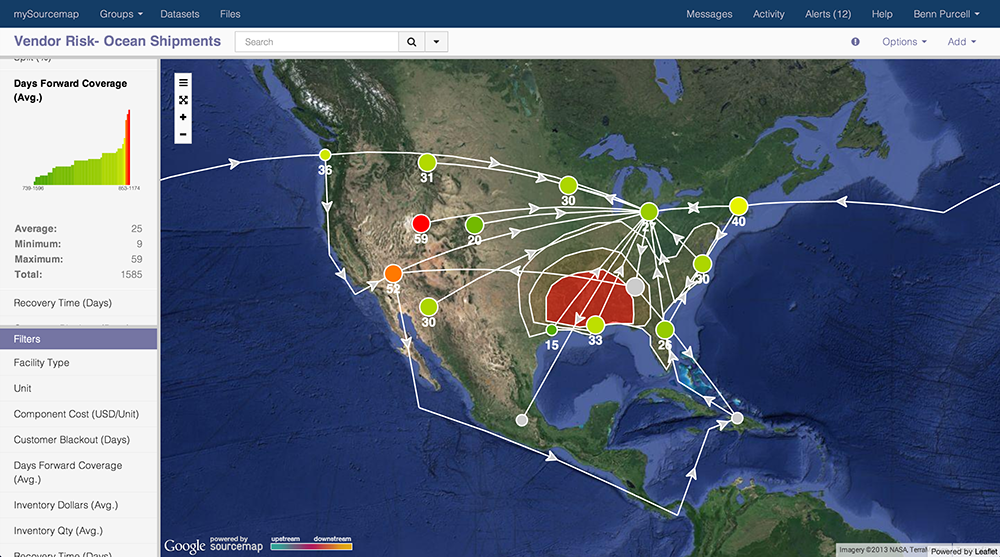
by Fronetics | Jul 20, 2015 | Blog, Logistics, Marketing, Social Media, Strategy, Supply Chain

Sourcemap: doing well by doing good.
Leonardo Bonanni’s company, Sourcemap, is doing well by doing good, and he’s helping companies to do the same. In working on his doctoral thesis at MIT, Leonardo Bonanni created a service that is good for the world on many levels – it saves companies money and it works towards sustainability through transparency. Bonanni is bringing the people what they want. Consider these numbers from recent surveys:
- more than 88% of consumers think companies should try to achieve their business goals while improving society and the environment
- 83% of employees would seriously consider leaving their job if their employer used child labor in sweatshop factories
- 65% would seriously consider leaving their job if their company harmed the environment
Bonanni’s innovative company, Sourcemap, helps clients visually map the supply chain route, from raw materials to end-users, providing unique and important visibility. Companies like Stoneyfield, Mars Chocolate, Fairphone, and Office Depot can see risks and disruptions in the supply chain in real time, act responsibly, promote sustainability, and please consumers who are increasingly curious and conscientious about materials sourcing.
The likes of the Wall Street Journal, Forbes, and The Guardian have taken interest in Dr. Bonanni and Sourcemap. Here he shares some insights with Fronetics on the growth of the company and how he won’t rest until mapping the supply chain is status quo.
What’s the most exciting thing going on at Sourcemap right now?
2015 is the year of supply chain mapping. When we started helping companies trace their products to the source, it was 2007 and the question was ‘why would we want to do that?’ Today it’s ‘how fast can we start?’ Whether it’s risk, sustainability, or simply finding more efficient ways to source products, companies need a big picture of the end-to-end supply chain. What’s exciting is how fast and far we help our clients get there – sometimes in as little as one day.
Tell me about how the maps are built. Are the maps on the free source platform built the same way as the maps on the enterprise platform?
Sourcemap started as a service for consumers to find out where products come from (free.sourcemap.com is still the only website where anyone can make a supply chain map, no training required). Users log in and map a supply chain – from raw material to end customer – as easily as drawing dots and lines on a Google map. Soon after the free website launched manufacturers approached us to see if we could help them figure out where their products come from. We had a lot of experience from serving millions of visitors through our free website, so we knew how to make a robust and intuitive interface for supply chain mapping. We adapted the technology to enterprise needs by adding company specific KPI’s, network analytics, and real-time reporting. The difference is that our enterprise users don’t draw the supply chains one link at a time. Their maps are automatically generated in near-real time from transportation, purchasing, and product lifecycle management databases.
Is it hard to convince businesses that there is an economic or competitive advantage to a utilizing a platform like Sourcemap?
It’s true that Sourcemap was originally built for sustainability, and it can be hard for companies to dedicate resources to long-term issues when short-term priorities come up every day. But our first success wasn’t helping companies be more sustainable in the long term. It was helping them tackle short-term crises, by developing a supply chain repository for emergency response and business continuity planning. Our clients were spending days and weeks to determine how a natural or human-made disaster was impacting any of thousands of suppliers worldwide. We brought that time down to minutes. Then supply chain managers started to see the benefit of knowing not just who they buy from, but who their suppliers buy from – and making decisions to consolidate or diversify supply, move inventories around, and decide when to in-source / out-source processes. These decisions represent huge savings in overall supply chain cost.
This is fantastic tool for companies who are proud of their supply chains, but what about those companies who aren’t, or who aren’t even fully aware of the steps and impact of their chain?
Over the years we’ve worked with companies big and small, with widely differing visibility into their supply chains. What we’ve seen is that the biggest benefit – the low-hanging fruits – are there for first-time supply chain mappers. These are companies that have expanded through acquisitions, are entering new markets or introducing new products – basically any organization that needs to account for a whole new way of doing business. Then, supply chain mapping is the easiest way to keep tabs on everyone in the supply chain and make sure that decisions are taken with an eye on the big picture.
In the years you’ve been doing this work have you seen a shift in consumer demand around the sourcing of materials and making of products? Is there increasing social pressure for companies to “do good”?
We’ve seen two drivers for supply chain sustainability and transparency: companies who want to attract the best talent, and brands looking to differentiate their product by providing information on its price, its composition, or its source.
Given that you teach at Columbia, I’m wondering if you see a difference in the passion, awareness, and attitude around sustainability with younger generations? Have you seen growth in the enrollment numbers in your classes?
I like to teach one or two evening classes a year (this Fall at NYU) to see how supply chain thinking is evolving as it becomes more mainstream. My class hasn’t changed much since it started in 2007, but the students have. Sustainability used to be a futuristic concern, and no one outside logistics departments ever talked about supply chains. Today there is a real desire among students to be social entrepreneurs, and part of that means thinking about products and services holistically – making sure that the social and environmental impacts are drivers of innovation, not just a nice-to-have. Enrollment has grown, and so has the number of departments where supply chains play a role: from engineering, architecture and design to business, public policy and international affairs.
Has social media played a role in the growth of the business and/or the operations of the business?
Sourcemap wouldn’t be here without social media. The fact that our supply chain maps can be embedded in other websites attracted over a million visitors in the first year. We saw brands embedding maps of their supply chains on their own websites, and we got a tremendous amount of traffic from being embedded and linked from the Huffington Post, Wired and Fast Company.
What are your ultimate goals for Sourcemap?
Supply chain mapping – knowing where products originate – gets easier the more companies do it. It requires information sharing, which means tighter collaboration between buyers and sellers. We’ve seen it become a requirement of purchasing departments: if you want to sell your products, disclose the raw material origins. That makes it easier to trust – and verify – the quality, the compliance, the sustainability of the product. Personally, I won’t rest until supply chain mapping becomes part of doing business as usual.
Dr. Leonardo Bonanni is Founder and CEO of Sourcemap, the supply chain mapping company. The New York-based startup offers enterprise software for companies to trace products, evaluate social, environmental and financial risks, and monitor improvements over time. One day soon you’ll be able to scan a product on a store shelf and be connected to the people who made it through the Sourcemap social network.
Leo is a supply chain transparency advocate named among the 100 Most Influential People in Business Ethics (2011) and America’s Most Promising Social Entrepreneurs (2012). He teaches sustainability at Columbia and at MIT, where he received his doctorate from the MIT Media Lab. He has a background as an architect, an inventor and a performer.
Fronetics Strategic Advisors is a leading management consulting firm. Our firm works with companies to identify and execute strategies for growth and value creation.
Whether it is a wholesale food distributor seeking guidance on how to define and execute corporate strategy; a telematics firm needing high quality content on a consistent basis; a real estate firm looking for a marketing partner; or a supply chain firm in need of interim management, our clients rely on Fronetics to help them navigate through critical junctures, meet their toughest challenges, and take advantage of opportunities. We deliver high-impact results.
We advise and work with companies on their most critical issues and opportunities: strategy, marketing, organization, talent acquisition, performance management, and M&A support.
We have deep expertise and a proven track record in a broad range of industries including: supply chain, real estate, software, and logistics.


by Fronetics | Jul 14, 2015 | Blog, Logistics, Manufacturing & Distribution, Strategy, Supply Chain

To see lean perfected – study the NASCAR pit. In a matter of seconds, the pit crew has changed tires, wiped down the windshield, filled up fuel, and given the driver a drink of water. Everything is in the right place at the right time. If only every distribution center would run that smoothly. What’s clear is that mastering inventory levels is central to the equation of eliminating waste, but inventory management is becoming a vexing problem for some organizations – compounded by multi-channel distribution, inadequate demand forecasting, and a lack of communication among appropriate parties.
Taking a closer look at the experiences of forerunner companies in their quests to master lean inventory management might just help your company avoid these top three snags.
Failure to Adapt Business Processes
In an effort to reduce merchandise sitting around on warehouse racks, some organizations take lean too far. The problem, in this case, is one of business process rather than software. While management sees the financial impact of cutting inventory, they tend to pay less attention to how it will affect operations. The heads of distribution quite frequently are not even invited to take part in the decision and find out only when fewer cases and pallets show up at receiving. Adapting business processes to involve the managers of procurement, finance, operations, and sales and marketing, is key to maximizing efficiency. In other words, open up the silo by building it in to your formal and informal processes.
Failure to Collaborate
Even with sophisticated demand forecasting models on hand, input from all parties is needed for an accurate assessment of inventory levels. And although demand forecasting can help an organization plan around high-level “what if” scenarios, it may not always be able to break it down on a granular level or take into account the increasing number of variables associated with multi-channel distribution. Collaboration is crucial.
Failure to Align Objectives
Sometimes the answer to the issue of inventory levels is counterintuitive. Even with lean as the driving force, the notion of optimization cannot be left out. In some instances, it makes sense to increase rather than minimize inventory if it will contribute to lowering your overall supply chain costs. Your business and inventory strategies need to align.
Despite the fact that in recent years the lean revolution has hit manufacturing, many organizations, especially retailers and wholesalers, have yet to apply lean principals. And among those who do dabble in lean, the focus tends to be on suppliers upstream rather than adding value to the end customer. As more and more businesses seek to tighten the management of their inventory in order to increase efficiencies, opportunities to address end customer value will emerge. Paul A. Myerson, professor in supply chain management, identifies store- and distribution operations as prime candidates since that’s where the most waste can be cut. He writes:
Distribution is all about optimizing the trade-offs between handling costs and warehousing costs, and maximizing the warehouse’s total cube—utilizing its full volume, while maintaining low materials handling costs and minimizing travel time.
Mastery of lean management principals will come for companies that are both successful in identifying new efficiency opportunities within their existing supply chain and navigating around the pitfalls of businesses that have instituted similar inventory management techniques.
Fronetics Strategic Advisors is a leading management consulting firm. Our firm works with companies to identify and execute strategies for growth and value creation.
Whether it is a wholesale food distributor seeking guidance on how to define and execute corporate strategy; a telematics firm needing high quality content on a consistent basis; a real estate firm looking for a marketing partner; or a supply chain firm in need of interim management, our clients rely on Fronetics to help them navigate through critical junctures, meet their toughest challenges, and take advantage of opportunities. We deliver high-impact results.
We advise and work with companies on their most critical issues and opportunities: strategy, marketing, organization, talent acquisition, performance management, and M&A support.
We have deep expertise and a proven track record in a broad range of industries including: supply chain, real estate, software, and logistics.


by Fronetics | Jul 9, 2015 | Blog, Data/Analytics, Marketing, Social Media
 In what seemed like a curious social experiment, KLM Royal Dutch Airline harnessed the popularity of social media and launched their “Meet and Seat” program in 2012. The service gives passengers the option to link their social media profiles to their boarding information during the ticket purchase process. Once a traveler’s profile is linked, they gain access to other social profiles of travelers that have also opted in to the service. Underling the concept is the notion that travelers will choose seatmates based on the profiles of users with similar business or leisure interests. While KLM reports that over 50,000 flyers have utilized the service since its inception – enough for KLM to deem the program successful – what’s discernable from KLM’s efforts is that social media has become a major player in today’s business world.
In what seemed like a curious social experiment, KLM Royal Dutch Airline harnessed the popularity of social media and launched their “Meet and Seat” program in 2012. The service gives passengers the option to link their social media profiles to their boarding information during the ticket purchase process. Once a traveler’s profile is linked, they gain access to other social profiles of travelers that have also opted in to the service. Underling the concept is the notion that travelers will choose seatmates based on the profiles of users with similar business or leisure interests. While KLM reports that over 50,000 flyers have utilized the service since its inception – enough for KLM to deem the program successful – what’s discernable from KLM’s efforts is that social media has become a major player in today’s business world.
With a reported 8 out of 10 businesses using social media in the communication between their brand and their audiences, companies are spending more marketing dollars on social efforts with increasing regularity. But with its fairly recent introduction to the business world, many companies are struggling to determine whether their efforts, and their investments, are paying off. Fortunately, by focusing on a few key metrics, your company can start to understand which of your social efforts are adding value and, just as important, which ones are not.
Here are the 4 social metrics that matter:
Source Reports
The most common remark about measurement you’ll hear social media marketing experts say is that social media efforts shouldn’t be solely measured in likes and follows. It’s hard to connect the number of likes and follows to financial business metrics, so thinking about the success of your channels in different terms gives a more insightful report about how your social channels are performing. HubSpot recommends tracking the network source of your web traffic, leads, and customers to determine how your social platforms are performing.
Track: # of visits, leads, and customers for each of your social channels
Engagement and Amplification
“No man is an island,” wrote John Donne in his poem. His summation about the nature of humans is quite evident in social media. Indeed, one of the greatest benefits of social media is that it is by its very nature, social. For companies, social media exponentially expands the reach of its content by playing on the communal nature of these networks. If a company has 2,000 followers on Twitter, and each of them shared that company’s content with 200 of their followers, the amplification of its content has expanded to 200,000 users. Your business can leverage these immense networks by maintaining consistency in the quality and value of your content as this strategy will naturally inspire followers to share and repost your content. Track the types of content that drives the most amplification and identify trends in popular publishing times, then refine your efforts based on your analysis. Remember, as a business using social media, your end goal is action, not eyes. In other words, what’s important to your efforts is engagement. Pay close attention to how your followers are interacting with your content.
Track: # of Facebook Post Shares, # of Retweets, # of Twitter Mentions
Lead Generation
Put simply, lead generation activity lets you know whether your social content is generating leads and creating opportunities for your business. At the end of the day, your social efforts don’t matter if they aren’t playing a part in driving new business. Of particular value to your business is your conversion rate. Knowing how often content consumption results in a new lead will help you to build a more successful overall content strategy. Is your new infographic converting visitors to leads at a higher rate than your verbose Facebook posts? That might be a sign that your audience responds better to image-heavy content.
Track: # of form submissions, # of email subscribers, conversion rate
Return on Investment
If one of your company’s objectives for its social media participation is to drive growth, your company’s ROI calculation is one of the most important measurements of your social efforts. This measurement determines what impact your social content is having on customer acquisition and sales. Just as you would for all other marketing efforts, you need to know whether or not the investment you’re making in social media is producing a positive return for your business. To find your investment, start by calculating the total of your investment, your overhead factor, and your miscellaneous costs. To calculate your return, you’ll need to know your leads per month, your lead conversion rate, your average lifetime customer value, and average profit margin. Let’s take a look at how those factor into your ROI calculation in the example below.
To Calculate Investment
- Multiply the hours per month needed to create the content by the hourly rate of the employees used to create the content.
- Multiply the result by the overhead factor, taking into account rent, insurance, utilities, etc. (typically 50%)
- Add all other costs, such as design fees, hosting fees, subscriptions, software, etc. You may choose to allocate them to a specific piece of content or amortize them monthly and spread the costs evenly across each piece of content.
Calculation: At 40 hours/month at $40/hour to produce a corporate blog, multiplied by a 50% overhead factor. Add in $1k/month for design, $100/month for hosting, and $100/month for miscellaneous fees.
Total Investment in Monthly Blog = $3,600
To Calculate Return
Multiply your leads per month by your lead conversion rate, average lifetime customer value, and average profit margin.
Calculation: You collect 25 leads a month from your blog. At a 20% lead conversion rate, you’ll generate five new customers. Assume a $3,000 average lifetime customer value and a 30% average profit margin.
Total Monthly Blogging Return = $4,500
To Calculate Return on Investment
Subtract the investment from the return. Then, divide by the investment.
Calculation:
$4,500 – $3,600 = 900
900/3,600 = .25
ROI = 25%
Nearly 70% of communications professionals report dissatisfaction in how they’re measuring their social efforts. That’s understandable, social can be cumbersome to analyze. But looking at activity through the lens of your business objectives should really get to the heart of why your company participates in social media. In your work to distinguish your company from the thousands of others in the sea of social, seek to create rich and robust social experiences for your followers by connecting them with relevant and valuable content. Then measure that user activity and engagement to see how it is helping grow your business.
Fronetics Strategic Advisors is a leading management consulting firm. Our firm works with companies to identify and execute strategies for growth and value creation.
Whether it is a wholesale food distributor seeking guidance on how to define and execute corporate strategy; a telematics firm needing high quality content on a consistent basis; a real estate firm looking for a marketing partner; or a supply chain firm in need of interim management, our clients rely on Fronetics to help them navigate through critical junctures, meet their toughest challenges, and take advantage of opportunities. We deliver high-impact results.
We advise and work with companies on their most critical issues and opportunities: strategy, marketing, organization, talent acquisition, performance management, and M&A support.
We have deep expertise and a proven track record in a broad range of industries including: supply chain, real estate, software, and logistics.


by Fronetics | Jul 8, 2015 | Blog, Content Marketing, Marketing, Social Media

By creating and distributing valuable and relevant content in a strategic and consistent manner you create demand for your products and services and drive profitable customer action. That being said, while content is king, content doesn’t go far (actually it goes nowhere) without distribution. For content to be successful for your business you need to do more than create content – you need to distribute content. Moreover, the content needs to be delivered consistently over time, at the right time, and in the right place.
Wise words by BuzzFeed’s Jonathan Perelman: “Content is king, but distribution is queen and she wears the pants.”
So how often should you distribute content via social media? While it is important to find the balance that is right for your business, here is what we have found to be effective and what we recommend:
12 to18 per day
Twitter
Business users should aim to tweet 12 to 18 times per day, not including replies and retweets. Twitter is likely the only social media network where it’s acceptable to push content out to followers with heavy frequency, but Twitter doesn’t filter users news feeds in the same way that Facebook does, so the lifespan of a tweet is only around 15 minutes. To get the most out of your content, try repurposing or repackaging it and publishing it multiple times a day. This strategy ensures your content goes farther and gains more exposure. Use social tools like HubSpot or Sprout Social to schedule posts at different times throughout the day as publishing content ahead of time frees up your time to respond and engage with users in real time.
1 time per day
Facebook
Companies generally find that posting 1 time per day is their sweet spot for most social media networks. Facebook’s algorithm determines what content is shown to each user, so it’s likely that your followers won’t see everything your business posts. Ensuring that your Facebook posts offer high quality content will work heavily in your favor as users who engage with your content are likely to see your posts with greater frequency. And your content lasts longer on Facebook; according to wisemetrics, a Facebook post reaches 75% of its potential engagement in 5 hours. A median tweet reaches this 75% mark in less than 3hrs. Be cognizant though of posting too frequently on this network; Social Bakers reviewed the Facebook posting habits of several large brands and found a correlation between increased posts (defined as more than 3 per day) and the loss of page likes.
Instagram
As with Facebook, businesses posting to Instagram should aim to publish content once per day. The caveat with Instagram is that posts shouldn’t exceed more than one per day. Unlike other wordy social networks like Facebook and Twitter, Instagram is the place for your company to convey its brand with images. A recent study by Forrester found that Instagram users were 58 times more likely to like, comment, or share a brand’s post than Facebook users and 120 times more likely than Twitter users. With more than 300 million active users, businesses that have found a way to leverage Instagram are boosting brand engagement and growing its customer base at an incredible rate, most with only one post per day.
LinkedIn
Because office workers not only take a break from their offices on weekends, but also from LinkedIn, companies should aim to post content once per day during the workweek. In fact, in a guide published by the social network itself, ideal posting frequency for businesses is 20 times per month. Beyond posts published by your company once per day, individual users from your business should be encouraged to engage frequently with peers in activities such as asking and answering questions with LinkedIn’s Group feature. To provide the most value for your LinkedIn followers, content should be less promotional, and more heavily focused on industry-wide trends and insight.
Google+
Companies tend to find that for Google+, once per day postings generate the most value. With the social network’s obvious search engine connection, user engagement on Google+ might not be as high as say, Twitter or LinkedIn, but there are anecdotal reports that maintaining active company profiles allows content to be indexed quicker on Google. Research shows five times as many people read a Google+ headline rather than the actual content, so spend some time crafting great headlines that succulently convey your company’s message.
At the end of the day, optimal posting frequency for your company rests heavily on the type of audience it wants to reach; experiment with different posting frequencies and let your own analysis be your guide. There’s a fine line between annoying your social followers and providing value. Maintaining a dynamic and fluid posting strategy will ensure that your social efforts drive followers to action, rather than drive them away.
Fronetics Strategic Advisors is a leading management consulting firm. Our firm works with companies to identify and execute strategies for growth and value creation.
Whether it is a wholesale food distributor seeking guidance on how to define and execute corporate strategy; a telematics firm needing high quality content on a consistent basis; a real estate firm looking for a marketing partner; or a supply chain firm in need of interim management, our clients rely on Fronetics to help them navigate through critical junctures, meet their toughest challenges, and take advantage of opportunities. We deliver high-impact results.
We advise and work with companies on their most critical issues and opportunities: strategy, marketing, organization, talent acquisition, performance management, and M&A support.
We have deep expertise and a proven track record in a broad range of industries including: supply chain, real estate, software, and logistics.


by Fronetics | Jul 7, 2015 | Blog, Marketing, Social Media, Strategy
With LinkedIn claiming the top spot for social networking professionals, there’s a good chance you already access the social network regularly. But what you might be missing on LinkedIn could be the key to unlocking more business opportunities.
Allow me to explain. There’s been a lot of talk about the impact social media is having on business sales. And for good reason – last year, the total amount of sales that could be tracked to social networks hit $3.30 billion, up 26% from 2013’s $2.62 billion. A growing number of companies are realizing there’s more opportunity than ever to use social platforms as lead generation and prospecting tools. When it comes to LinkedIn, reports suggest that users who command a deeper understanding of the social network’s capabilities reap far greater benefits than those that still view LinkedIn primarily as a job search tool.
One of LinkedIn’s best features for driving new business leads and opportunities is LinkedIn Groups. LinkedIn describes their Group feature as a “place for professionals in the same industry or with similar interests to share content, find answers, post and view jobs, make business contacts, and establish themselves as industry experts.” Essentially, it’s an online community where you can connect with industry peers and like-minded professionals (read: prospects and leads).
Never tried Groups before? Here’s a quick guide to get you up and running so you can start prospecting and finding leads today. As a prerequisite, you should already have an active LinkedIn account. If you don’t, start here.
Find Groups
To start, let’s take Groups out for a spin. From the homepage, navigate to the search bar at the top and click on the tab directly to the left on it. Drag down to “Groups”, then, type in a subject you’re interested in (e.g., marketing, sales, baking, etc.). You might notice that when you do a search, LinkedIn also provides suggestions not only on “Groups” but in several other categories such as “Connections,” “Companies,” “Features” and “Skills.” Once you’ve used your keyword to narrow your search, find a group that best matches what you’re looking for.
Cast a Wide Net
Once you’ve selected your group, join it. You may have to request membership approval if it is a private group. While there’s no limit to the amount of groups you can join, the sweet spot for lead generation is to join groups that are outside your industry or function that might help you grow your business. If you’re a small (and growing) 3PL, for example, don’t just industry groups, expand your network by joining groups for entrepreneurs and small business owners.
Commit to Building Your Network
Set aside some time each week to connect with five current or former business colleagues. LinkedIn makes it easy by providing suggestions based on your current connections and places of employment. More connections equal more opportunities for discussion about your company’s products and services.
Answer like a Pro
Use the Answers section within your groups as a place to showcase your expertise. Set a goal to answer at least two questions per week. After actively participating in a group for at least two weeks, start your own discussion within the group. Engaging industry peers in a rich dialogue is a great way to build trust and confidence among members of your new group. Turning your question and answering activity into leads is a long-term strategy, but one that can prove successful as people will begin to look at you as an expert and leader in your industry.
Practice Consistency
The key to generating leads via LinkedIn is consistency. Steady participation in your groups is the secret is to building relationships that will pay off in the end. Take some time to determine what’s working in your strategy and refocus your efforts as necessary, but always, always be consistent in your participation. In the end, it’s your activity that is going to set you apart from the competition and establish your expertise.
In a recent survey of sales professionals, most reported they were unfamiliar with LinkedIn’s full capabilities, but in the same survey, a little more than a third of respondents reported generating new business opportunities and revenue gains from their use of LinkedIn. It’s clear that the social network holds opportunity for those that recognize – and leverage – the network’s full capabilities.
Fronetics Strategic Advisors is a leading management consulting firm. Our firm works with companies to identify and execute strategies for growth and value creation.
Whether it is a wholesale food distributor seeking guidance on how to define and execute corporate strategy; a telematics firm needing high quality content on a consistent basis; a real estate firm looking for a marketing partner; or a supply chain firm in need of interim management, our clients rely on Fronetics to help them navigate through critical junctures, meet their toughest challenges, and take advantage of opportunities. We deliver high-impact results.
We advise and work with companies on their most critical issues and opportunities: strategy, marketing, organization, talent acquisition, performance management, and M&A support.
We have deep expertise and a proven track record in a broad range of industries including: supply chain, real estate, software, and logistics.









